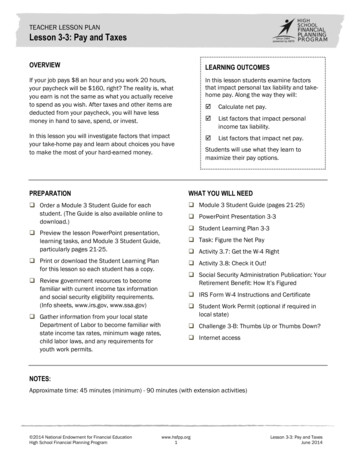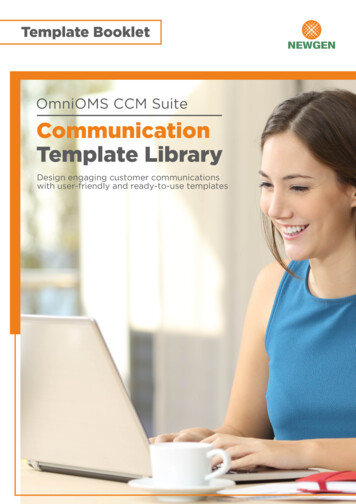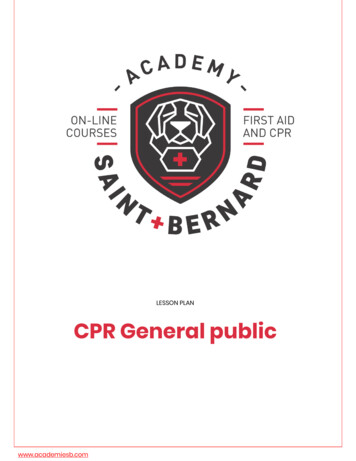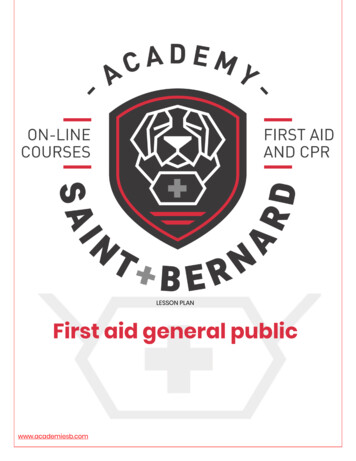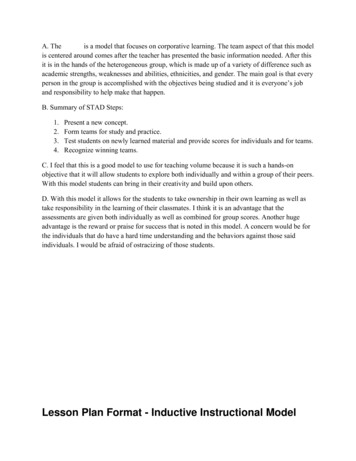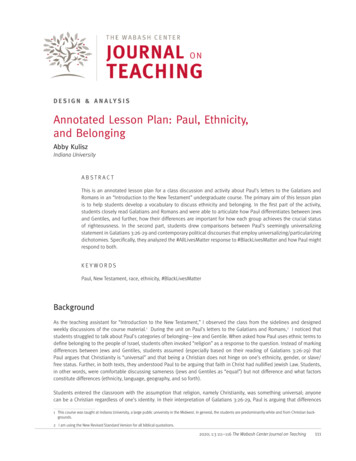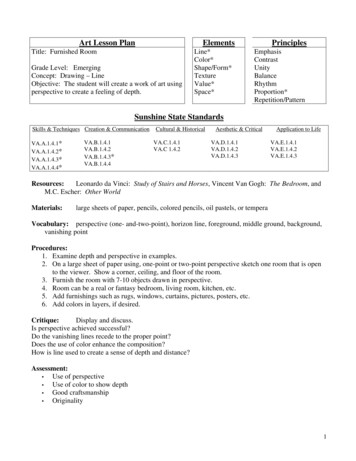
Transcription
Art Lesson PlanElementsTitle: Furnished RoomGrade Level: EmergingConcept: Drawing – LineObjective: The student will create a work of art usingperspective to create a feeling of n*Repetition/PatternSunshine State StandardsSkills & Techniques Creation & ltural & HistoricalVA.C.1.4.1VA.C 1.4.2Aesthetic & CriticalVA.D.1.4.1VA.D.1.4.2VA.D.1.4.3Application to do da Vinci: Study of Stairs and Horses, Vincent Van Gogh: The Bedroom, andM.C. Escher: Other WorldMaterials:large sheets of paper, pencils, colored pencils, oil pastels, or temperaVocabulary: perspective (one- and-two-point), horizon line, foreground, middle ground, background,vanishing pointProcedures:1. Examine depth and perspective in examples.2. On a large sheet of paper using, one-point or two-point perspective sketch one room that is opento the viewer. Show a corner, ceiling, and floor of the room.3. Furnish the room with 7-10 objects drawn in perspective.4. Room can be a real or fantasy bedroom, living room, kitchen, etc.5. Add furnishings such as rugs, windows, curtains, pictures, posters, etc.6. Add colors in layers, if desired.Critique:Display and discuss.Is perspective achieved successful?Do the vanishing lines recede to the proper point?Does the use of color enhance the composition?How is line used to create a sense of depth and distance?Assessment: Use of perspective Use of color to show depth Good craftsmanship Originality1
Art Lesson PlanElementsTitle: Lines of Common ObjectsGrade Level: ProficientConcept: Drawing – LineObjective: Practice accurate contour drawing ofcommon tionRepetition/PatternSunshine State StandardsSkills & Techniques Creation & tural & HistoricalVA.C.1.4.1VA.C 1.4.2Aesthetic & rl Umlauf: Altered States V, Alberto Giacometti: Still Life (1948)Materials:drawing paper, pencil, pen and ink, brushesVocabulary:contour line, asymmetrical balance, texture, rhythm, line varietyApplication to LifeVA.E.1.4.1VA.E.1.4.2VA.E.1.4.3Procedures:1. Set up 8-10 common household objects around the classroom. (stool, ironing board, iron, broom,hair dryer, etc.)2. Have students draw each object carefully using a pencil.3. Encourage unique viewpoints (looking up into the stool or the ironing board).4. Encourage overlapping of objects.5. Encourage creative use of cords on appliances to fill in space and create a visual rhythm.6. Use a pen and brush with India ink to go over pencil lines.7. Add textures with dry brush technique (bristles of broom) and crosshatching.Critique:How have the objects created asymmetrical balance?Describe where repetition and line have created rhythm.Where have you used dry brush for texture?Assessment: Good contour sketches revealing observation Use of asymmetrical balance, overlapping, rhythm, line variety Creative, good craftsmanship2
Art Lesson PlanElementsTitle: Still Life Value DrawingGrade Level: AdvancedConcept: Drawing – LineObjective: The student will practice using shading orchiaroscuro to make a flat surface seem to have rtion*Repetition/PatternSunshine State StandardsSkills & Techniques Creation & ltural & HistoricalVA.C.1.4.1VA.C 1.4.2Aesthetic & casso: Woman in White, Escher: Tower of Babel, etc.Materials:drawing paper, pencilsVocabulary:shading, blending, chiaroscuro, value scale, light source, shadowsApplication to LifeVA.E.1.4.1VA.E.1.4.2VA.E.1.4.3Procedures:1. Examine and discuss works showing chiaroscuro and strong value contrasts.2. Set up a still life with a strong light source.3. Sketch all or a portion of the still life.4. Establish a value scale of 8-10 values on the objects.5. Use chiaroscuro technique to create 3-D illusion.6. Add lines in the negative space.Critique:Display and discuss works showing chiaroscuro to create the illusion of form on a 2-Dsurface.Has value created a sense of depth?How have the lines achieved depth?Is there a strong contrast in value?Assessment: A variety of values Values indicate forms Good craftsmanship Originality3
Art Lesson PlanElementsTitle: Contour Line FigureGrade Level: EmergingConcept: Design – LineObjective: The student will be able to produce adrawing that follows the figures Repetition/PatternSunshine State StandardsSkills & Techniques Creation & Communication Cultural & HistoricalAesthetic & CriticalApplication to 1.4.1VA.C 1.4.2Resources:George Romney: Lady Hamilton as Ariadne, Torii Kiyonobu: Actor as a MonkeyShowmanMaterials:pen/ink or felt tip pens, drawing paperVocabulary:blind contour, contour lineProcedures:1. Introduce students to contour with blind contour exercises of each others faces2. Discuss outlines and contours – show examples.3. Set up student models.4. Practice 3 or 4 contours of models.5. Select best and apply light watercolor washes.Critique:How hard was it not to pick up your pencil?Did you follow all the contours?Is your drawing an outline drawing?Assessment: Use of contour drawing method Watercolor wash enhances figure contours Figure composed well on format4
Art Lesson PlanElementsTitle: Contour Line Still Life of PlantGrade Level: ProficientConcept: Design – LineObjective: The student will observe from life toproduce a contour line drawing of a epetition/PatternSunshine State StandardsSkills & Techniques Creation & Communication Cultural & HistoricalAesthetic & CriticalApplication to 1.4.1VA.C 1.4.2Resources:Matisse: Woman With Folded Hands, Ellsworth Kelly: ApplesMaterials:felt tip pens, India ink and pens or Sharpie markers, white tag or artist drawing paperVocabulary:contour line, composition, positive/negative, balanceProcedures:1. Set up a still life that includes a plant and a cloth with patterns.2. The student will draw the still life with contour line. Do not place the plant in the center of thepage.Critique:Does the positive space balance the negative space?Discuss outline versus contour.Assessment: Contour line Balance Composition Good craftsmanship5
Art Lesson PlanElementsTitle: Cubist Influenced ObjectGrade Level: AdvancedConcept: Design – LineObjective: The student will create a work of art froman object using the Cubistic influence of Braque tionRepetition/PatternSunshine State StandardsSkills & Techniques Creation & Communication Cultural & HistoricalAesthetic & CriticalApplication to C.1.4.1*VA.C 1.4.2Resources:Georges Braque: Violin and Palette, Picasso: Ma JolieMaterials:pen and ink, paper, objectsVocabulary:crosshatching, value, Cubism, geometricProcedures:1. Discuss Cubism.2. Show examples of Braque, Picasso and Cubism.3. Hand out an object that has geometric forms found in the shape of it.4. Have students draw the object, then create extensions with lines found naturally in the piece.5. Duplicate parts of the object to complete composition.6. Add value to finish.Critique:Did extension of lines from the object create focus?How did this help your work?How was the idea of Cubism achieved?Assessment: Use of Cubism Use of pen and ink Composition Range of values Good craftsmanship6
Art Lesson PlanElementsTitle: Photo ExtensionGrade Level: EmergingConcept: Drawing – ShapeObjective: The student will draw imaginaryextensions around a chosen photograph glued to thedrawing epetition/PatternSunshine State StandardsSkills & Techniques Creation & Cultural & HistoricalVA.C.1.4.1VA.C 1.4.2*Aesthetic & n to dor Dali: The Weaning of Furniture-Nutrition or Persistence of Memory, DavidHockney:, Rene Magritte: The Enchanted Domain seriesMaterials:magazines, scissors, glue, pencil, colored pencils, 12” x 18” drawing paperVocabulary:shape, space, extension, detail, landscapeProcedures:1. Select a section of a magazine landscape photo that shows space.2. Glue it onto the drawing paper, but not exactly in the center.3. Extend the lines and shapes of the picture into your own landscape.4. Add objects from your imagination into your picture.5. Add color with colored pencils.Critique:Display and discuss.What edges seen in your selected photo did you extend into your drawing?How did your additions enhance the feeling of space in your work?Do you think your drawing is successful?Why or why not?Assessment: Filling paper with drawing Extension of lines in photograph Addition of original elements Craftsmanship All areas are in color7
Art Lesson PlanElementsTitle: Plant Shapes with PatterningGrade Level: ProficientConcept: Drawing – ShapeObjective: Students with create a composition ofdrawn and stenciled organic onRepetition/Pattern*Sunshine State StandardsSkills & Techniques Creation & ultural & HistoricalVA.C.1.4.1VA.C 1.4.2*Aesthetic & CriticalVA.D.1.4.1*VA.D.1.4.2VA.D.1.4.3Application to LifeVA.E.1.4.1VA.E.1.4.2VA.E.1.4.3Resources:Need artists books with examples of patterns, Gustav Klimt: The Kiss, The Book ofKeus: Opening Page of St. Luke’s GospelsMaterials:of plantsArches paper, pencil, color pencils, spray paint, stencils, tracing paper or mylar, varietyVocabulary:shape, design, repetition, texture, composition, organic, geometric, overlapping, patternProcedures:1. Draw a live or artificial plant from observation.2. Make a stencil of the drawing, add multiples of this shape to the composition with drawing, andspray paint.3. Add patterning to at least three areas using colored pencils.4. The three areas chosen should cover at least a third of the artwork.5. Limit main colors to three.Critique:How have you balanced drawn and spray painted shapes?Is your color scheme effective?Point out the organic and geometric shapes you have used. Point out where the shapes overlap.Assessment: Balanced composition Effective use of overlapping shapes and patterning Good craftsmanship Good technique in use of paint and colored pencil8
Art Lesson PlanElementsTitle: Shallow Space Still LifeGrade Level: AdvancedConcept: Drawing – ShapeObjective: The student will paint a tromp d’oeil stilllife of objects that illustrate their self ProportionRepetition/PatternSunshine State StandardsSkills & Techniques Creation & *Cultural & HistoricalVA.C.1.4.1*VA.C 1.4.2*Aesthetic & on to LifeVA.E.1.4.1VA.E.1.4.2VA.E.1.4.3*Resources:still life paintings from the Baroque period, contemporary work such as that of Janet Fish andAudrey Flack: Marilyn, William Harnett: The Old ViolinMaterials:watercolor paper (at least 12” x 18”, preferably 18” x 24”), pencil, ruler, watercolors, brushes,water containers, paper towels, sponges, palettes, still life objects (include flatter objects such as open booksand magazines, notebook paper, postcards, keys, ribbons and yarn, pencils and paint brushes, tubes of paint,scarves and doilies, etc.Vocabulary:still life, close up, overlapping, tangent, contour, value, shallow space, wash, graded wash, drybrush, wet-into-wet, tromp d’oeilProcedures:1. Each student will arrange his own still life on a board so that it will not have to be moved from day to day.Objects should reflect the student’s interest/self portrait.2. Objects should be overlapped and “layered” to create the depth in this arrangement.3. Students are to draw these objects life size or larger, and should let the objects run off the paper.4. There should be no negative space around the edges.5. Paint the still life with watercolor.6. Use the various techniques taught previously, such as graded and flat wash, dry brush, and wet- into-wet.7. Shadows should be added, and especially noticeable at the tangents of shapes.Critique:Do the objects appear to be real so to fool the eye?Point out the locations of the various watercolor techniques you used.Why did you choose the objects you did?From what direction is the light coming in your still life?Select an area of texture in your still life and describe how you created it.Assessment: Composition (overlapping, negative spaces) Use of various painting techniques Value and shading Neatness, good craftsmanship9
Art L
3. Set up student models. 4. Practice 3 or 4 contours of models. 5. Select best and apply light watercolor washes. Critique: How hard was it not to pick up your pencil? Did you follow all the contours? Is your drawing an outline drawing? Assessment: Use of contour drawing method Watercolor wash enhances figure contours Figure composed well on format . 5 Art Lesson Plan. Elements .
